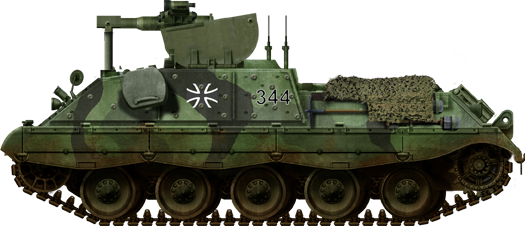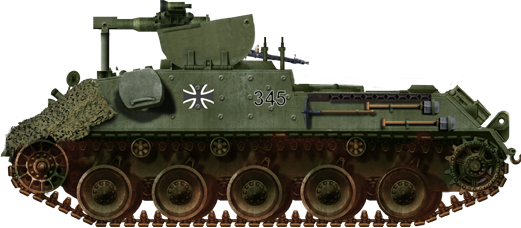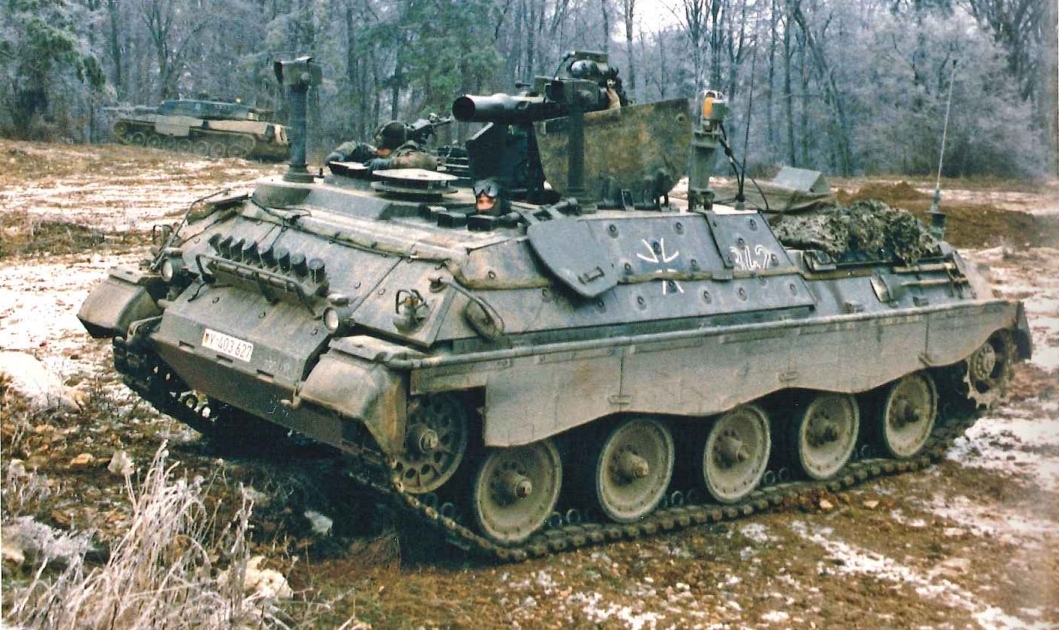RktJgPz-4 Jaguar 2
 West Germany (1982) - Missile tank, 162 converted
West Germany (1982) - Missile tank, 162 converted
Full name: Jagdpanzer Jaguar 2 mit Panzerabwehrlenkflugkörper TOW
Development History
The West German Bundeswehr during the Cold War faced the reality of having an enormous mass (est. 20,000 in 1985) of Soviet Tanks ready to invade at any moment, and the number of main battle tanks in service was not sufficient to stop them, even with coalition forces (US and British Tanks of the BAOR). So considerable efforts were put into the development of anti-armor capabilities. Aisde the Leopard 2 in 1978 one of the key developments for Bundeswehr was to devise anti-tank missiles platoons and in general, tracked tank hunter carrying them, an asset that can defeat any incoming tank at distances they could answer.In the 1960s with Nord co. from France, Bolköw developed the SS-10 missile for the Bundewehr, making into the first of the Ratekenjagdpanzer or "rocket tank hunters", developed at first on the HS.30 chassis. Abbreviated RktJpz-1 and 2, hundreds were made, taking part in exercises in the 1960-70s. However as soon as the more modern HOT missile appeared, the Raketenjagdpanzer was developed around it, and its larger size and different systems urge the creation of a brand new vehicle, the Raketenjagdpanzer-3 "Jaguar-1" that made the gap until the end of the cold war.

Design Development of the Jaguar 4
After the Raketenjagdpanzer-1 based on the Spz Lang HS.30 IFV chassis, in 1966 was introduced the RktJgPz-2, in service until the early 1980s, co-produced both by Henschel and Hanomag (318 delivered). France and Germany developed in between the second-generation antitank missile "HOT" between Aérospatiale (Nord assets were now part of it) and MBB (same for Bölkow). The same companies, at the root of today's euromissiles, also developed the MILAN and Roland. The missile allowed the Raketenjagdpanzer-2 and upgrade to this excellent missile, leading to the development of the Raketenjagdpanzer-3.Called "Jaguar 1", abbreviated RakJPz 3 it was still the same tracked base with an Anti-Tank Guided Missile (ATGM) launcher in the central compartment. The compartment in the Jaguar 1 was converted from SS-11 to the HOT with a new ATGM launcher featuring eight ready in quick reload carousel, and twelve additional reloads for the carousel.
General Design
The vehicle weighed 25.7 tons, for an overall length of 6.6 meters, a width of 3.12 meters, and a height of 2.55 meters. Its crew of four comrpised the front driver, a commander, the gunner and missile loader.BGM-71 TOW missile
The name TOW stands for "Tube-launched, Optically tracked, Wire-guided". This was an iconic cold war American anti-tank missile. It replaced much smaller missiles like the French SS.10 and ENTAC, with twice the effective range twice as heavy warhead, greatly improved semi-automatic command to line of sight (SACLOS). The latter was soon equipped with infrared cameras to fire by night or in poor weather.First produced in 1970, this became one of the most widely used anti-tank guided missiles worldwide, distributed to NATO and to nations in the US sphere of influence in general. It was also adapted to a wide variety of manually carried or vehicle-mounted systems, and under arms of helicopters. Hughes Aircraft was the one behind the design in the 1960s, whikle production (still ongoing) passed on to RTX.
- Dimensions: 1.16–1.17 m with probe folded x 152 mm (1.41–1.51 ext.), wsp 0.46 m
- Total Weight: 54.5 lbs (24.7kg)
- Warhead: 3.9–6.14 kg (penetration 430–900 mm RHA)
- Speed: 278–320 m/s
- Range: 3,000 m, most variants 3,750 m
- Guidance: Optically tracked, wire-guided (wireless radio-guided in RF variants)
Jaguar 2 detailed design
The tank destroyer experienced a further increase in combat effectiveness as part of the conversion of 162 KanJPz to the RakJgPz Jaguar 2 with the PzAbwLFK. The RakJgPz Jaguar 2 TOW is an armored tracked vehicle for long-range anti-tank defense (up to 3,750 m). The front half of the chassis contains the fighting compartment for the four-man crew as well as the LFK firing device (lifting carriage) and the LFK supply. The rear part of the chassis is taken up by the engine including the cooling system and fuel tanks. The torsion bar-sprung 5-roller chassis is covered on all sides by a tracked apron. The area of the fighting compartment is provided with adapted additional armor at the front and on both sides.In contrast to the RakJgPz Jaguar 1, the LFK TOW is fired and steered with the roof hatches of the fighting compartment open, and the launcher must also be reloaded manually. From 1989, LFK TOW 2 were purchased, which are characterized by a more powerful warhead and greater immunity to interference. This LFK can also be used from the JPz JAGUAR 2. By attaching the AN/TAS-4 night vision device to the launcher of the LFK TOW, the JPz JAGUAR 1 was capable of night combat from the start of use. The weapon system can also be used away from the vehicle if necessary thanks to the tripod carried on board.
The chassis is not shared with the Marder IFV unlike the Jaguar I but base don the older Jagpanzer 90. It still had six evenly-spaced roadwheels resting on torsion bar suspensions, three return rollers, rear drive sprocket, front idler. The powerplant was a 29,4l MTU MB 837 Aa V8 water-cooled multi-fuel diesel which was rated for 500 hp (368 kW). Top speed was 70 km/hr and range up to 400 km. The company behind were the same (Hanomag and Henschel) that reated the Jagdpanzer 90-mm tank hunter and first Raketenjagdpanzer armed with SS-11 ATGM. The Jaguar 2 was conceived as a better protected alternative to the M113 variants already equipped with the TOW missiles.
So from 1983 through 1985, 162 of the previously 770 built Jagdpanzer 90 were taken out of depots and reconverted to operate the TOW missile system, others being transferred to territorial forces. The trick was to install the new TOW launcher in place of the former 90 mm cannon, which mount was removed entirely, freeing a large space forward of the hull. The glacis nose was plated over and an extra armour plate was added.
The TOW launched was placed on a lifting platform, which can be depressed and lowered when traveling. There was an AN/TAS-4 thermal-imaging sight added to the launcher. The launcher was redesigned to fit whereas the hull reinforced with add-on armor similar to the Jaguar-1A3. The TOW launcher was given a 300° in azimuth (traverse) and -10 to +15° in elevation, placed in fighting compartment behuibnd the driver's and commander's position that were in front of the vehicke with their own hatch each. When fully raied, the TOW launched was elevated via an hydraulic drive, through two half-moon hatches opening in a transverse fashion. These armored hatches stayed locked up when fiuring, providing extra protection for the operator, fully exposed when firing.
The Jaguar-2 is fully protected NBC, with an air filtration system, night-driving sight for the driver, a full set of modernized radios, plus a battery of eight smoke-grenade launchers in a forward nose arrangement (on the sides for the Jaguar 1). The Jaguar 2 is protected by a single 7.62-mm machine gun mounted on a gun ring on the commander's cupola. Armor protection was reinforced by bolting additional steel plates to the frontal arc and sides. The armored hull showed indeed the same prismatic shape as its predecessors, with rolled RHA plates, sloped sides. Armour thickness went up to 50mm on the front glacis. Bolted add-on armor consisted in 20 mm extra plating forward, 10mm on sides.
The 7.62mm MG3 medium machine gun for close defense was manned by the commander from his cupola, on a ring mount. Unlike the previous Jaguar 1, the bulk of the new launcher eliminated the ball mount LMG. Some tooling was installed aft on the engine deck sides. Two whip antennae are located at the rear of the fighting compartment.
Operational service
The Raketenjagdpanzer-4 Jaguar 2 resulted in the conversion of 162 Kanonenjagdpanzers in 1982-85, and added their weight to 318 Jaguar 1 based on the Marder chassis.Sources/Links about the Raketenjagdpanzer-2
The Rktjpz-4 on military factory On panzerbaer.de Panzer-modell.de On fas.org On globalsecurity.org The Kanonenjagdpanzer on weaponsystems.net russellphillips.uk HOT missile (wiki) old-forum.warthunder.com Jag 2 Tech museum KoblenzThe Raketenjagdpanzer-4 Jag 2 (wiki)
Bundeswehr 1984 archive footage from the Raketenjagdpanzer Jaguar
Jaguar-2 specifications | |
| Dimensions | 8,75 x 2,98 x 2,10 m (345 x 117 x 82 in) |
| Total weight, battle ready | 25 tons (49,000 ibs) |
| Crew | 4 (Driver, commander, operator, loader) |
| Propulsion | MTU MB 837 V8 diesel 500 hp (368 kW) |
| Suspension | Independent torsion bars |
| Speed (road) | 70 kph (44 mph) |
| Range | 385-400 km (240 mi) |
| Armament | TOW missiles (3750 m range), 1x 7.62 mm MG3 |
| Armor | 70 mm front (1.96 in) |
| Conversion | 318 in 1978-82. |

Jaguar 2 with early livery, 1985.

Camouflaged Jaguar 2, late 1990s.
Gallery
Jaguar 1 in HGM Panzerhalle

Model kit




Cold War Tanks


































Cold war tanks posters

Cold War Main Battle Tanks

Cold War Soviet Army
Museums, Movies, Books & Games
The Tanks and Armor in pop culture
Tanks and armored vehicles in general are only really grasped when seen first person: The mass, the scale, it's all there. Explore also the way tanks were covered in the movie industry, in books and in video games.Movies:
Best tanks movie on warhistoryonline.com
On imdb.com
On bestsimilar.com/
miltours.com
liveabout.com/
watchmojo.com
Video Games:
pcgamesn.com
historyhit.com
levvvel.com
vg247.com/best-tank-games
mmobomb.com/
alienwarearena.com
